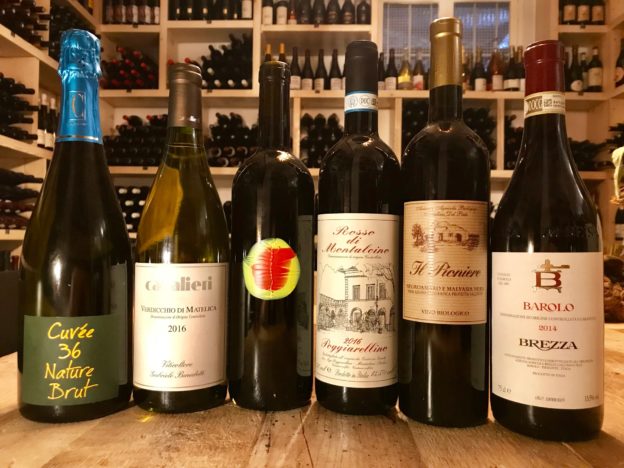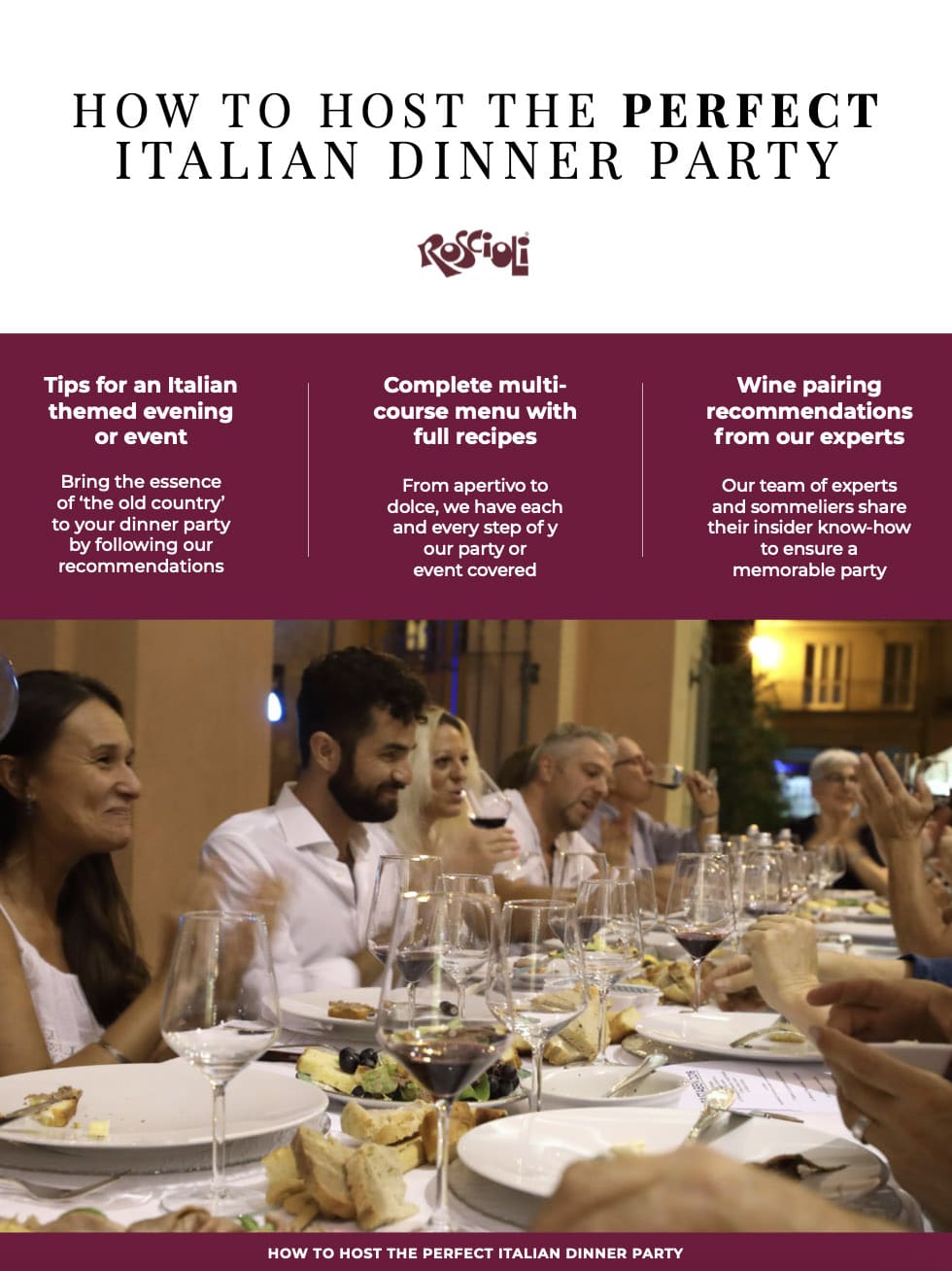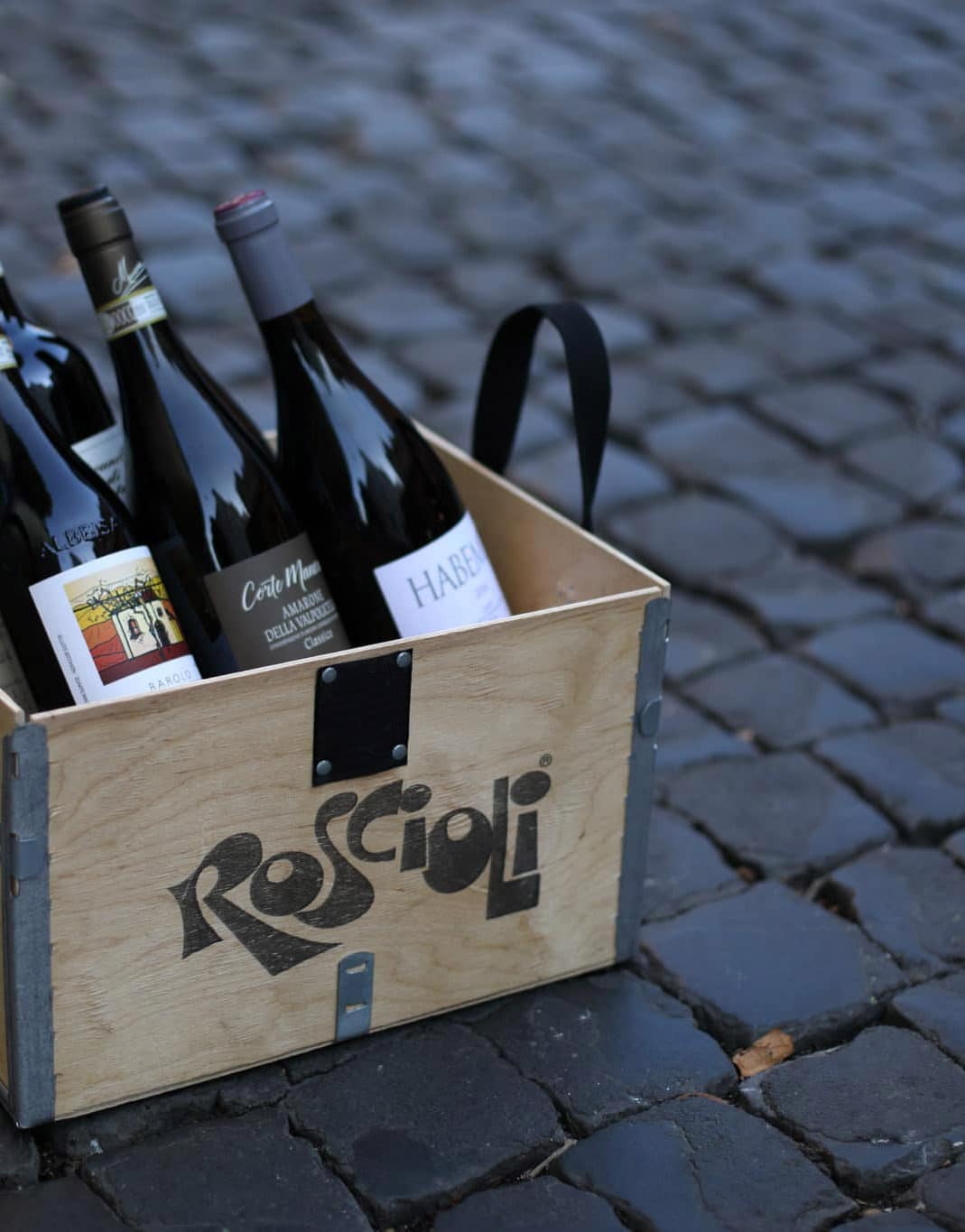SPUMANTE METODO CLASSICO BRUT NATURE '36', CASA CATERINA
Grape: 100% Chardonnay Region: Franciacorta (LOMBARDIA) Pairings: good friends, a romantic dinner, and just about anything from lobster, shellfish, white fish, quality cured meats…try to pair with a nice dinner Notes: Harvested and riddled by hand, 36 months of aging on lees Drink by: now through 2022 Description: THE 'DIALECT' WINE How I wish you were all Italians, not because of our arrogance, nor because we have the worst political class in Europe, neither for the mafia or for the anarchic individualism that characterizes us, and certainly not even for our presumptions. I would like you to be Italian to feel the nuance of the accent of Aurelio and Emilio del Bono. They speak an Italian that I would call rural, with an accent that tells them culturally and physically. Difficult to translate into another language: maybe Midwest if you are American, Cockney if you are Londoners, Argot if you are French. In short, their cadence is one with their wines and one day I will write a guide about the dialects and wines of Italy. Because perhaps this is the secret, it is through the declinations of the Logos (or Koine) that the untranslatable Terroir is defined. In short, tell me how you speak and I will tell you what wine you produce. To explain where we are, we're speaking of Brescia, 100km east of Milan, the road to Venice to be exact. Soft, pre-Alpine hills are home to a community that was rural up to 40 years ago and today is one of the most prolific industrial sectors in Europe. The Brescian is of few words and of a tireless activity. Rude, direct, guttural, earthy. That type of peasant who suffered the Austrians, the French, the Milanese, the Germans, but remained anchored to his land. The Brescians are hard and tough as ancient oaks, and don't budge for anything. In this way, Aurelio says that he does the bubbles with natural fermentation, without adding yeasts, with a perfect ripening of the grapes, unlike many of his colleagues who own Brescia are not doing and who prefer to harvest early to have a raw grape but with a high acidity. If you do not understand what I'm talking about here is a video that explains it: Watch the video HERE All that Giovanni Arcari knows (see video above) he owes to Fratelli del Bono. At the end of the eighties these two rough peasants already spoke of natural fermentation when barriques, designer enologists and selected yeasts were discussed all over the world. And it is not that the Del Bonos anticipated the times, simply they stopped time, firmly anchored to their traditions. Because it is these accents on these cadences that defines the rustic elegance of those wines capable of being on the border between tradition and modernity, between Italian and dialect. The 36-month Cuvee is fresh and ripe at the same time, but the descriptive notes you'll have to find them yourselves, because if you ask the del Bono's, they'll respond with an insult. I call it the only Italian sparkling that does not make me regret not having opened a Champagne. The 60-month is more mature, deliberately oxidized. You can hear the passage of time, with notes of honey and yeast. Match them with a meal, as this is not an aperitive wine.VERDICCHIO DI MATELICA 2016, CAVALIERI
Grape: 100% Verdicchio Region: Matelica (MARCHE) Pairings: perfect with fish, scampi or vegetable risotto, or most oven baked or grilled fish Notes: organically farmed, fermented/aged in cement and stainless steel, 15,000 bottles produced Drink by: now until 2022 Description: He explains things well. The practice of free run wine from gravity is interesting, not very common. For the rest, there is little to add. The Verdicchio in Jesi and Matelica in my opinion is among the best white in Italy. If you are not too impatient, leave the wine for a few years in the cellar to see the evolution. We drank some from his cellar nearly 20 years old. If you can not, as I believe, at least drink it slowly and feel the evolution in the glass, as you go from the fruit to salt. These wines are unique - don't expect an obvious sauvignon blanc here. Matelica and Jesi differ from their positions and soil. Matelica sits at a higher elevation with cooler temperatures, has more dense soil, which often bringing more floral notes and minerality to the wine. Here they are bordered on the east and west by mountains, whereas Jesi gets the currents from the sea from the east. Pair this with a simple fish or white meat dish and let the wine be the unique standout.NEGROAMARO MALVASIA NERA 'IL PIONIERE' 2016, NATALINO DEL PRETE
Grape: 80% Negroamaro and 20% Malvasia Nero Region: Salice Salentino (PUGLIA) Pairings: semi-aged cheeses like pecorino, foods from Puglia like a spicy Calabrese salami, slowly cooked lamb, even pastas and pizza Drink by: now through 2022 Notes: organically farmed, indigenous yeasts, 70 year old vines, non-filtered, non-clarified, no added suflites! Description: So, more I speak with wine makers and more I get confused. I thought that green manure was a must, I thought that Primitivo was a traditional grape variety from Italy, I thought that South Italian wines from Puglia were all alcoholic and heavily fruity. I thought… until I met Natalino. Forget about green manure here, he said, Primitivo was reintroduced mainly in the 80’s because of the American market (primitivo is genetically similar to Zinfandel) and old vineyards not fertilized can give you here elegant and fresh wines. And also… Natalino is a 78 years old vineyard man, in the sense that he leaved in the vineyard for the last 68 years of his life. He has been producing Negroamaro, Malvasia Nera, Aleatico and a bit of Primitivo ( but he’s not happy about it, even if it is the the number one sale) First of all open his wine 2-3 hours before, let it breath, then… pour it in the glass and slowly perceive the unusual freshness of a wine coming from one of the hottest regions of Italy. What is surprising in this bottle is the dirty elegance, the complex simplicity, soft tannins, plums and cherry and this predominant earthy finish, not mineral but earth. What’s the difference: to me earthy means mineral plus soil, mould and liveness. Something like organic minerals, maybe. In fact a taste of a sunny land by the sea. So a natural traditional Puglia wine. What is so special about it? So special is that Del Prete is one of the only producers that still make this type of wine in this region. A type of wine that was not ruined by the over alcoholic, fruity, jammy market. Have it with some light pecorino cheese, or also a plate of pasta con le sarde (pasta with sardines) if you have a good Sicilian restaurant nearby. But more important please try not to get disappointed if you don’t find that big fruity and chemical flavor of most of the industrial Puglia wines. Just let this wine go as it is, because Natalino is a treasure to defend, for it’s simplicity, it’s clear point of you, his straight light vision of how simple and hard is to make wines respecting the climat, the soil, the grape variety and the tradition.ROSSO DI MONTALCINO 2016, POGGIARELLINO
Grape: 100% Sangiovese Grosso Region: Montalcino (TOSCANA) Pairings: beef, pork and lamb dishes, even goose or duck Drink by: now through 2021 Notes: made from all Brunello grapes/territory just in Rosso ageing procedure (shorter), large Slovenian oak, non-filtered Description: I'm not going to tell you a story... The suspension of judgment - Epoche - according to the ancient Greeks was the basis of true knowledge. And so a Zen story talks about the professor who wants to know Buddhism and goes to a hermit who pours him a cup of tea and continues to pour until it spills out of the cup and the professor says: what are you doing? And the hermit laughs: How can you know if you do not first empty your cup of preconceived and preconceived knowledge. And more times we have said how often children are capable of the most daring and relevant descriptions in judging a wine. And we have also reported studies of neurology that confirmed the fact that between Logos - word/story - and wine there was an unbridgeable neuronal distance due to the simple fact that the palate and taste and smell are primordial and instinctive, geographically distant from the side of the brain that develops language. And finally, there are times that one would like to remain silent and let the wine, in its evocative power, ancestral and tribal, speak for itself, of senses and not of sense, through emotions and suggestions rather than scores and descriptions. So speaking with Anna and Lodovico there are no clear statements, stories about their land, the history and the taste that make the world of wine the most lied about market in the world. Lodovico says he does not go to the fairs because he is shy. Anna argues with the keys of the gate and takes her with her husband who would like to expand the cellar: but where do you want to go at 82? he says to her. Then he speaks of the regret of having to abandon his business upon reaching limits of age without anyone in the family who wants to take it (and we immediately say 'we'll take it over' - part joking, part serious) In short, the story of two simple Tuscan people, without particular stories, who shy away from the silly circus of storytelling about false terroirs and false traditions. Two humble and beautiful people who make a wonderful wine, surrounded by woods, facing the Montosoli Hill, the only true area of Montalcino. The rest, in the valley, are thousands of hectares of commercial fruit and built up stories of a wine that has become too famous too quickly, just a label without substance. To combine with silence, pleasure, and those rare moments when we can simply enjoy something without judging it.BARBERA 'ASCARO' 2013, FAUSTO ANDI
Grape: 100% Barbera Region: Oltrepò Pavese (LOMBARDIA) Pairings: red meats, especially anything wild Notes: bio-dynamically produced, not filtered or fined, indigenous yeasts, 6,500 bottles produced Drink by: now through 2023 Description: No, we are not in Tuscany... To get there just go to the south of Milan for about 85 km. You will find yourself in the middle of beautiful hills, you will seem to be in Tuscany with the advantage of not having Tuscans around, and especially not have their sweetened, counterfeit wines, built for tourism and the palate of corrupt journalists. Fortunately no one really cares about Oltrepo, except for some rare and passionate admirers. Here we make wines from Uva Rara, Croatina, Moradella, Barbera. I'm not going to explain what is in each because some of these grapes they don't even know. But I can tell you that among these vineyards a farmer is working and puts you in peace with the world. Fausto Andi tells a story of 6 generations of land and vineyards through technical descriptions for initiates, so you will not understand everything about his speech, but basically what it means is that there is only one way to make wine and it is by respecting the plant and its unique and inimitable relationship with the soil and the climate it belongs to. The vigneron is a custodian of territorial uniqueness. Without rhetoric Fausto tells his wine not as if he were the father, but a midwife. Everything is in accompanying the fruit at birth, he says. I would try to describe the wine, but what is the use? I could speak of an almost sweet fruit and then a unique soft winding that turns to finish of a balsamic, mineral freshness, with notes of violet and licorice ... seems ridiculous? Or At least out of place? Come on, put these post-wine-snob descriptions next to Fausto and you'll notice that something is screaming. How to go dressed in tights at a country fair, or with a mask and fin at a Wall Street session. The point is that the Andi family has been studying organic farming for more than 100 years, before the fashion of wood, winemakers, wine and natural fermentation arrived. To be combined with fatty meats and a country house, far from suspicious noises, but not those of the maison. For another video on Fausto Andi (subtitles coming momentarily):BAROLO 2014, BREZZA
Grape: 100% Nebbiolo Region: Barolo (PIEMONTE) Pairings: aged cheese, like Parmigiano Reggiano, red meats, stews, wild game Drink by: now until 2028 (but best in youth vs aged) Notes: large Slovenian oak 24 moths, no new oak, shorter maceration (respect to their Cru), 27 year-old vines Description: Well, I had never understood how to taste a wine through a sound. Yes, really, when it makes that sound on your palate at 0:40. Ciack. Ciack, is it not beautiful, to hear that noise, with that gesture of the hands? Then what do you say? 'The credibility of pleasure' A phrase from the encyclopedia of taste. Credible pleasure is a perfect synthesis of the sense of taste. And it 's true, Barolo is the wine of dawn, because it is the only wine that dries and enriches the palate, leaving you always in an intermediate zone between heat and tannin that brings you to drink it and redrink it, until dawn precisely. The Brezzas, if you want to know, have been making wine for 120 years in Barolo. A terrace overlooking Cannubi, perhaps the oldest and most famous vineyard in Italy and no concession to passing fashions. Large barrels, long refinements, elegant, blasamic wines, fine but structured that dry the palate, ciack, clapperboard. These wines beg for an aged cheese, a slice of cured meat, bread, water and another sip. Repeat the process over and over until the sun rises.How to Host the Perfect Italian Dinner Party
Bring Italy to you with our free guide to planning and hosting the perfect Italian dinner party!
Find recipes, wine paring recommendations and other tips for a memorable evening, all curated by our team of experts - download today here:
 SEI IN ITALIA? CLICCA QUI
SEI IN ITALIA? CLICCA QUI 



